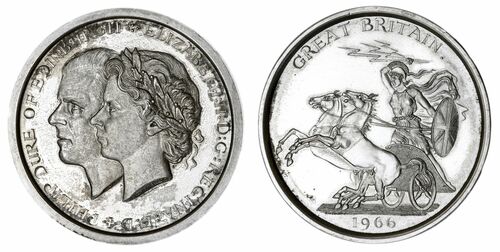
Auction: 24123 - British and World Coins and Medals featuring the Pritchard Collection of 18th Century Provincial Tokens and Commemorative Medals - e-Auction
Lot: 1076
NGC SP61 | Elizabeth II (1952-2022), Unofficial 'Foley and Hunt' Pattern Silver Crown of Five-Pounds, 1966, struck c. 1965, in .925 Silver, by Anthony M. Foley and K. C. Hunt of the Royal Mint for the British Treasury, ELIZABETH : II : D : G : REGINA : F : D + PHILIP DUKE OF EDINBURGH, laureate and conjoined busts left, rev. GREAT BRITAIN, Britannia riding left in biga pulled by two rearing horses, hurling three thunderbolts, 1966 in exergue, plain edge, 35.70g, 12h (ESC 393Q; Bull 4347), light hairlining in brilliant fields, with smoky-grey mottled toning within the legends and upon the portraits, much as struck and thus highly desirable in commerce, additionally of great significance in the Decimalisation of the British specie, in NGC holder, exceptionally harshly graded SP61 (Cert. #6767984-001)
The Pritchard Collection of 18th Century Provincial Tokens and Commemorative Medals
In 1961 the Government set up a special committee to consider the introduction of decimalisation. This had in fact been addressed a century earlier, but it wasn't until the 1st of March 1966 that the Chancellor of the Exchequer, James Callaghan, finally announced that an overhaul of the coinage system was to be implemented. He announced: "it is the government's conclusion, shared I know by large sections of industry, commerce, science and banking, that the change to a decimal coinage will bring considerable benefit to the economy at large".
It was during this half a decade at the start of the 1960s that British medallists Foley and Hunt made a case to the British Treasury to produce Twenty-Five Pound pieces struck in gold and Five Pound Pieces to be struck in silver. Foley believed that these would greatly benefit the British economy and would earn more than ten million pounds in foreign currency. It is thought that as few as 100 silver pieces were created. The design was never adopted when decimalisation was introduced in 1971 and therefore it remains an unofficial pattern. However, the concept of the coin, in terms of its proposed monetary value, and its artistic design completely embodies this energetic period in British currency; not only were new ideas emerging and actively being pursued, but it ultimately changed the face of British coinage forever.
Subject to 20% VAT on Buyer’s Premium. For more information please view Terms and Conditions for Buyers.
Sold for
£5,200
Starting price
£800




